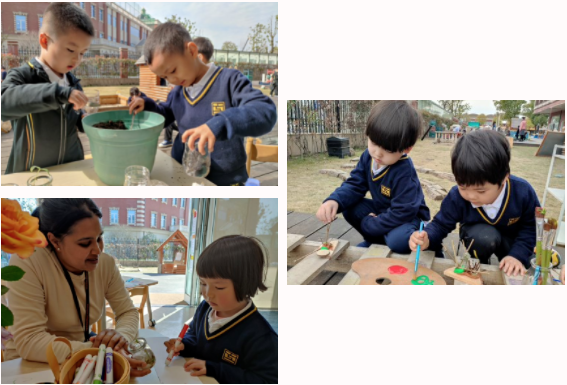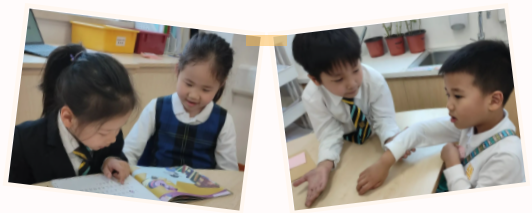
EY1 Matters

EY1 Children had the opportunity to match items to photos, such as garlic bulbs, sand, grass, and plants. The children had further opportunities to categorise these various items into living and non-living by colour and if they have a scent? Soil, pots, trowels, and spades were put out to invite children to feel a different texture in their hands and experience a new material to fill the pots and practice planting natural materials. This independent exploration was provided before Ms Delphine and Ms Judy’s bilingual session, in which the children had a go at planting natural seeds to grow into herb plants.
EY2 Matters

Take a closer look at our beans...what do you notice? What has changed? What will they look like when they grow bigger? As we began to see changes in growth with our beans, the children represented their learning and wondered what the beans would become and what they would look like when they grew. Will the bean turn into a tree, flower, fruit or vegetable? At Huili Nursery Hangzhou, teachers embed rich mark-making opportunities throughout the learning environment and within the daily rhythms of class routines. During English sessions, children recall the growth of their bean and wonder what it will become, what size it will be, what colour with this be? A beautiful sight to behold is when children begin to use mark-making to represent their name. Although the letters may be upside down or back to front, the children recognise their marks as a useful way to show their name. It gives all children a keen sense of pride and identity. Providing meaning to marks they make is a wonderful way for children to talk and develop their language. Children begin to listen with intent and share similar ideas. This leads to more opportunities for children to retrieve information from books or the internet to research their learning ideas further.
EY3 Matters

To guide children’s learning in an open-ended investigation to reinforce reflective thinking, interpret emotions, and build literacy skills to explain and react to the feelings of a story, we guided children on a series of dramatic, imaginative sessions. For example, EY3 children became a group of snails on a rock, surrounded by the ocean. We prepared a general sequence of plot events and yet carefully observed and recorded children’s input, feedback, and responses to shape the course of the discussion and story. The tiny snails used descriptive language to describe and imagine their life on the rock and their thoughts about leaving the rock for the world. Children evaluated different arguments made by the grandpa snail (played by Ms Cindy) and the red bird (played by Ms Lora) about whether to stay on the rock or leave to explore the world, debating their beliefs with others. This week’s drama sessions covered other elements related to caring for the environment and understanding how human actions impact the natural world. A lovely element about incorporating drama in education is how it creates a safe environment for children to process real emotions, beliefs, and experiences in the setting of a make-believe situation. Acting allows for children to take in and deal with information in a way otherwise hard to replicate by story or discussion alone.
EY4 Matters

EY4 children received letters from their counterparts in Grade 1 as part of the transition process. Our children had to write back to Grade 1 children introducing themselves. We used this unique opportunity to practice introducing ourselves to other people when we first met them. The children first practised introducing themselves in English orally. We supported the children with relevant vocabulary to help them communicate their ideas effectively. Once they had enough practice with their talk partners, they wrote their introductions. The children applied the principle of ‘Think it, Say it, Write it’ to help them write. After the children had finished their first draft, we got them together to review their work. We went back to look at what makes a good sentence: capital letters, finger spacing and full stop. The children then looked at their initial draft and identified what they needed to improve. They corrected their work and wrote their final letters to their Grade 1 counterparts. We then went to see the Grade 1 children and presented our letters to them. We also met the teachers in Grade 1 and interacted with them and the children. It was a wonderful experience, and we hope to revisit them.